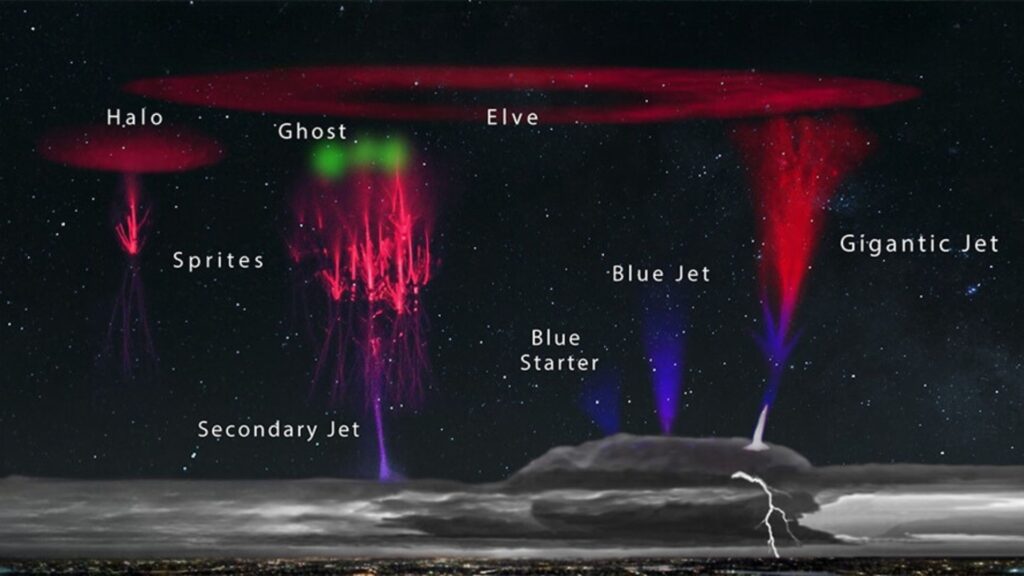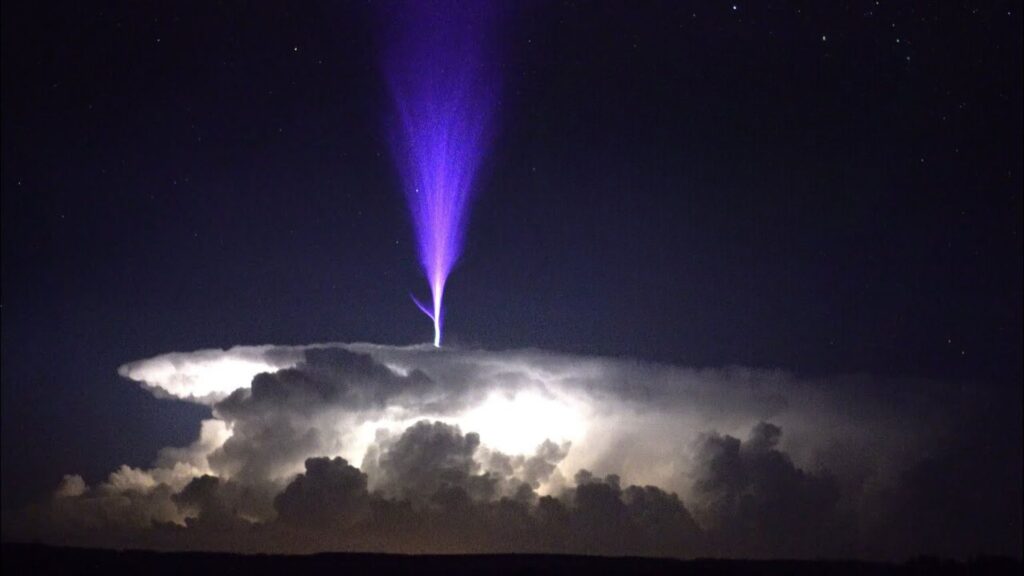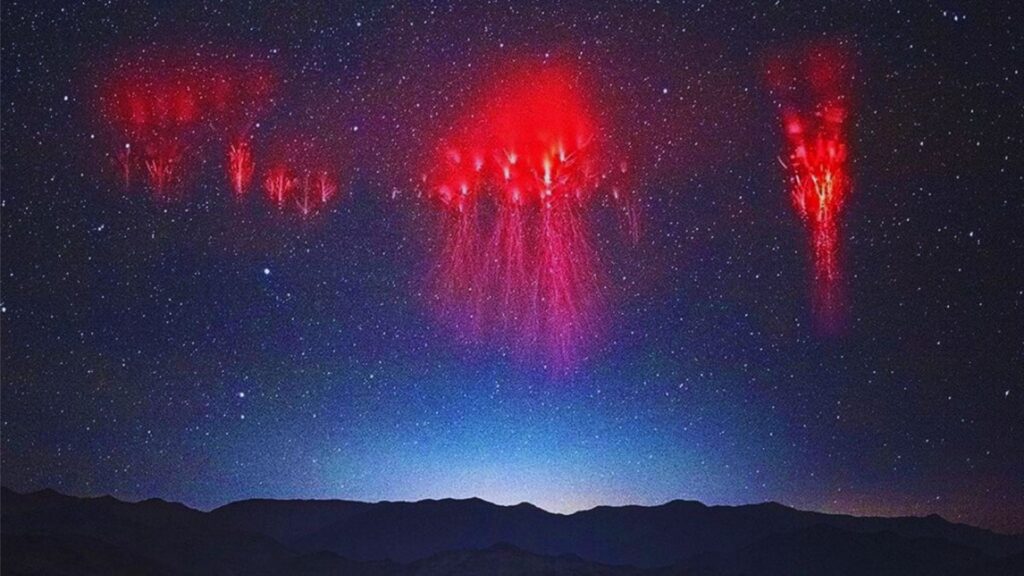Introduction
When we think of lightning, we usually envision bolts of electricity striking the ground in a brilliant display of nature’s power. However, there are other fascinating phenomena that occur high above thunderstorms, known as Transient Luminous Events (TLEs). Among these mysterious events are red sprites and blue jets, which have captured the attention of both scientists and weather enthusiasts alike. In this blog post, we will delve into the science behind these extraordinary events and explore how they differ from one another.
Transient Luminous Events: A Brief Overview

Transient Luminous Events (TLEs) are short-lived optical phenomena that occur in the upper atmosphere, usually in connection with thunderstorm activity. They are classified into several types, including:
- Red sprites: large-scale electrical discharges that occur high above thunderstorms, characterized by their red hue.
- Blue jets: upward-moving, cone-shaped bursts of blue light that originate from the tops of thunderstorms.
- Gigantic jets: large, blue discharges that reach altitudes higher than blue jets, often connecting the thunderstorm with the ionosphere.
- Elves: rapidly expanding, doughnut-shaped glows that occur at the base of the ionosphere and last for only a few milliseconds.
- Halos: the diffuse, circular glow that occurs just below the ionosphere, typically accompanying red sprites.
To further explore the captivating world of atmospheric light phenomena, don’t miss our comprehensive article, “Dancing Skies: A Guide to Atmospheric Light Phenomena,” which delves into various mesmerizing displays in the skies above.
Red Sprites

Red sprites are massive, jellyfish-shaped discharges that occur at altitudes of 50 to 90 kilometers (30 to 56 miles) above thunderstorms. They are typically red in color due to the excitation of nitrogen molecules in the atmosphere, which emit red light when they return to their normal state. Red sprites can span several tens of kilometers in both horizontal and vertical directions and last for only a few milliseconds.
Case Study: Red Sprite Observation
In 1994, researchers at the University of Alaska Fairbanks captured the first high-quality video of a red sprite, revealing its unique structure and behavior. Since then, numerous observations and studies have been conducted, enhancing our understanding of this enigmatic phenomenon.
Blue Jets

Blue jets, on the other hand, are upward-moving, cone-shaped bursts of blue light that originate from the tops of thunderstorms. They typically occur at altitudes of 20 to 50 kilometers (12 to 31 miles) and can extend upward for several tens of kilometers. The blue color of these jets is a result of the excitation of oxygen molecules in the atmosphere. Unlike red sprites, blue jets are more difficult to observe due to their lower altitudes and shorter lifespans, usually lasting only a few tens to hundreds of milliseconds.
Case Study: Blue Jet Observation
In 2016, the European Space Agency (ESA) released images of blue jets captured by the Atmosphere-Space Interactions Monitor (ASIM) aboard the International Space Station (ISS). This provided scientists with valuable data on the detailed structure and behavior of blue jets, which had previously been difficult to obtain.
If you’re interested in observing celestial events and atmospheric phenomena from the comfort of your own home, take a look at our recommendations for the Best Telescopes of 2023 to find the perfect instrument to suit your needs.
What Causes Red Sprites and Blue Jets?
For centuries, eyewitness accounts have described peculiar flashes of light above thunderstorms. However, it wasn’t until 1989 that these events were first captured on film. At the time, researchers from the University of Minnesota were testing a low-light TV camera for an upcoming rocket mission when, purely by chance, they recorded the initial substantiated evidence of what we now refer to as sprites.
The exact mechanisms behind the formation of red sprites and blue jets are still not fully understood. However, it is believed that both phenomena are related to the charge imbalances that occur during thunderstorms.
For red sprites, it is hypothesized that they are triggered by positive cloud-to-ground lightning, which leaves a charge imbalance in the upper atmosphere. This imbalance can then generate an electric field strong enough to initiate a large-scale discharge in the form
of a red sprite. Additionally, it is thought that the presence of a mesospheric “quasi-electrostatic field” plays a crucial role in the development of red sprites.
In the case of blue jets, they are believed to be initiated by charge imbalances within the thundercloud itself. When a strong electric field forms between the positively charged upper part of the cloud and the negatively charged lower part, the resulting discharge can create a blue jet that propagates upward through the atmosphere.

The Importance of Studying Red Sprites and Blue Jets
Understanding the processes behind red sprites and blue jets is crucial for several reasons. First and foremost, these phenomena provide insight into the complex electrical processes that occur within our atmosphere. By studying TLEs, scientists can learn more about the interactions between thunderstorms, the Earth’s atmosphere, and the ionosphere.
Additionally, red sprites and blue jets may have implications for climate research. Some studies suggest that these events could play a role in the transport of chemical species between different layers of the atmosphere, potentially affecting the composition and chemistry of the atmosphere itself.
Finally, the study of TLEs may have practical applications in fields such as aviation and satellite technology. For example, understanding the behavior of red sprites and blue jets could help improve safety measures for aircraft flying near thunderstorms, as well as inform the design of satellites and other space-based instruments that need to withstand the harsh conditions of the upper atmosphere.
Conclusion
Red sprites and blue jets are just two examples of the fascinating Transient Luminous Events that occur high above thunderstorms. As we continue to study these mysterious phenomena, we not only gain a deeper understanding of the Earth’s atmosphere and its electrical processes but also open the door to potential applications in various fields. With ongoing research and advancements in observation technology, we are sure to uncover even more secrets about these awe-inspiring events in the years to come.
For a deeper understanding of the various captivating displays in the sky, be sure to check out our informative guide on Atmospheric Light Phenomena, which covers a wide range of awe-inspiring events.
